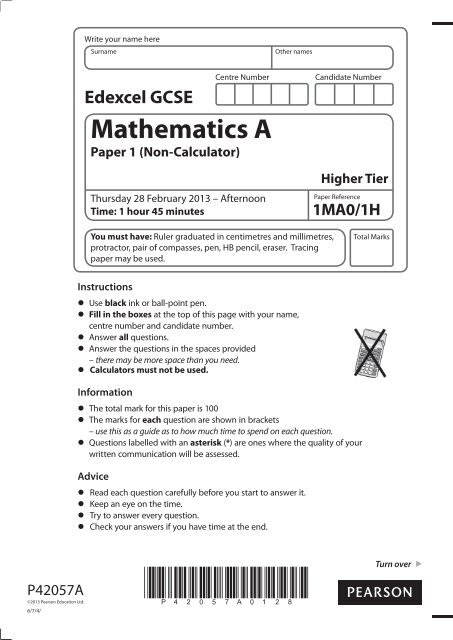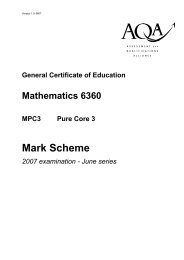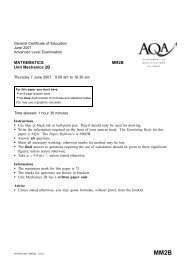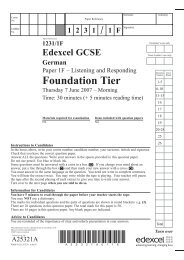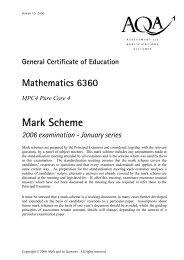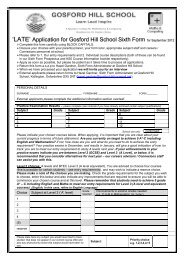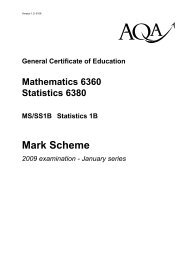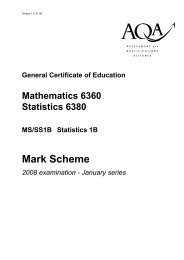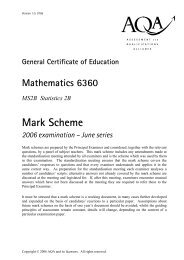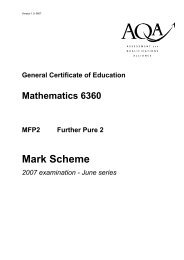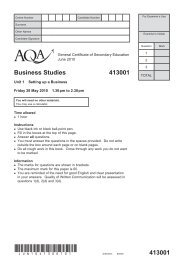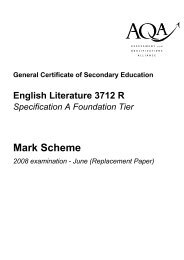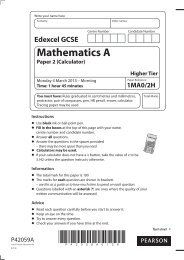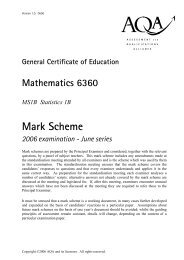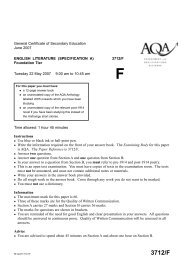Paper 1 Non- Calculator - kesh gcse maths
Paper 1 Non- Calculator - kesh gcse maths
Paper 1 Non- Calculator - kesh gcse maths
Create successful ePaper yourself
Turn your PDF publications into a flip-book with our unique Google optimized e-Paper software.
Write your name here<br />
Surname<br />
Other names<br />
Edexcel GCSE<br />
Centre Number<br />
Mathematics A<br />
<strong>Paper</strong> 1 (<strong>Non</strong>-<strong>Calculator</strong>)<br />
Thursday 28 February 2013 – Afternoon<br />
Time: 1 hour 45 minutes<br />
Candidate Number<br />
Higher Tier<br />
<strong>Paper</strong> Reference<br />
1MA0/1H<br />
You must have: Ruler graduated in centimetres and millimetres,<br />
protractor, pair of compasses, pen, HB pencil, eraser. Tracing<br />
paper may be used.<br />
Total Marks<br />
Instructions<br />
<br />
<br />
Use black ink or ball-point pen.<br />
Fill in the boxes at the top of this page with your name,<br />
centre number and candidate number.<br />
Answer all questions.<br />
Answer the questions in the spaces provided<br />
– there may be more space than you need.<br />
<strong>Calculator</strong>s must not be used.<br />
Information<br />
<br />
<br />
The total mark for this paper is 100<br />
The marks for each question are shown in brackets<br />
– use this as a guide as to how much time to spend on each question.<br />
Questions labelled with an asterisk (*) are ones where the quality of your<br />
written communication will be assessed.<br />
Advice<br />
<br />
Read each question carefully before you start to answer it.<br />
Keep an eye on the time.<br />
Try to answer every question.<br />
Check your answers if you have time at the end.<br />
Turn over<br />
P42057A<br />
©2013 Pearson Education Ltd.<br />
6/7/4/<br />
*P42057A0128*
GCSE Mathematics 1MA0<br />
Formulae: Higher Tier<br />
You must not write on this formulae page.<br />
Anything you write on this formulae page will gain NO credit.<br />
Volume of prism = area of cross section × length<br />
Area of trapezium = 1 2<br />
(a + b)h<br />
cross<br />
section<br />
h<br />
a<br />
length<br />
b<br />
Volume of sphere = 4 3 3<br />
Surface area of sphere = 4 2<br />
Volume of cone = 1 3 2 h<br />
Curved surface area of cone = <br />
r<br />
l<br />
h<br />
r<br />
In any triangle ABC<br />
A<br />
b<br />
c<br />
C<br />
a<br />
B<br />
The Quadratic Equation<br />
The solutions of ax 2 + bx + c = 0<br />
where 0, are given by<br />
b b ac<br />
x = − ± ( − 4 )<br />
2a<br />
2<br />
Sine Rule<br />
a b c<br />
= =<br />
sin A sin B sinC<br />
Cosine Rule a 2 = b 2 + c 2 – 2bc cos A<br />
Area of triangle = 1 2<br />
ab sin C<br />
2<br />
*P42057A0228*
Answer ALL questions.<br />
Write your answers in the spaces provided.<br />
You must write down all stages in your working.<br />
You must NOT use a calculator.<br />
1 Work out 1.83 × 47<br />
.......................................................<br />
(Total for Question 1 is 3 marks)<br />
*P42057A0328*<br />
3<br />
Turn over
2 The scatter graph shows information about 10 apartments in a city.<br />
The graph shows the distance from the city centre and the monthly rent of each<br />
apartment.<br />
600<br />
500<br />
400<br />
Monthly<br />
rent (£)<br />
300<br />
200<br />
100<br />
0 0<br />
1 2 3 4 5 6<br />
Distance from the city centre (km)<br />
The table shows the distance from the city centre and the monthly rent for two other<br />
apartments.<br />
Distance from the city centre (km) 2 3.1<br />
Monthly rent (£) 250 190<br />
(a) On the scatter graph, plot the information from the table.<br />
(1)<br />
(b) Describe the relationship between the distance from the city centre and the monthly rent.<br />
..................................................................................................................................................................................................................................................<br />
..................................................................................................................................................................................................................................................<br />
(1)<br />
4<br />
*P42057A0428*
An apartment is 2.8 km from the city centre.<br />
(c) Find an estimate for the monthly rent for this apartment.<br />
£ ......................................................<br />
(2)<br />
(Total for Question 2 is 4 marks)<br />
3 Paula wants to find out how much money people spend buying CDs.<br />
She uses this question on a questionnaire.<br />
How much money do you spend buying CDs<br />
£10 – £30 £30 – £50 £50 – £70 more than £70<br />
(a) Write down two things wrong with this question.<br />
1 .............................................................................................................................................................................................................................................<br />
..................................................................................................................................................................................................................................................<br />
2 .............................................................................................................................................................................................................................................<br />
..................................................................................................................................................................................................................................................<br />
(2)<br />
Paula asks 100 people in a CD store to do her questionnaire.<br />
(b) Her sample is biased.<br />
Explain why.<br />
..................................................................................................................................................................................................................................................<br />
..................................................................................................................................................................................................................................................<br />
(1)<br />
(Total for Question 3 is 3 marks)<br />
*P42057A0528*<br />
5<br />
Turn over
4 (a) Complete the table of values for y = 2x + 5<br />
x –2 –1 0 1 2<br />
y 1 5<br />
(2)<br />
(b) On the grid, draw the graph of y = 2x + 5 for values of x from x = –2 to x = 2<br />
y<br />
10<br />
9<br />
8<br />
7<br />
6<br />
5<br />
4<br />
3<br />
2<br />
1<br />
–2 –1 O 1 2<br />
–1<br />
x<br />
(2)<br />
(Total for Question 4 is 4 marks)<br />
6<br />
*P42057A0628*
5 Here are the first 5 terms of an arithmetic sequence.<br />
3 9 15 21 27<br />
(a) Find an expression, in terms of n, for the nth term of this sequence.<br />
....................................................................<br />
(2)<br />
Ben says that 150 is in the sequence.<br />
(b) Is Ben right<br />
You must explain your answer.<br />
..................................................................................................................................................................................................................................................<br />
..................................................................................................................................................................................................................................................<br />
..................................................................................................................................................................................................................................................<br />
(1)<br />
(Total for Question 5 is 3 marks)<br />
*P42057A0728*<br />
7<br />
Turn over
6 You can use this conversion graph to change between pounds (£) and dollars ($).<br />
18<br />
16<br />
14<br />
12<br />
10<br />
Dollars ($)<br />
8<br />
6<br />
4<br />
2<br />
0<br />
0 1 2 3 4 5 6 7 8 9 10 11 12<br />
Pounds (£)<br />
(a) Use the conversion graph to change £5 to dollars.<br />
Ella has $200 and £800<br />
Her hotel bill is $600<br />
Ella pays the bill with the $200 and some of the pounds.<br />
(b) Use the conversion graph to work out how many pounds she has left.<br />
$ ....................................<br />
(1)<br />
(Total for Question 6 is 5 marks)<br />
£ ....................................<br />
(4)<br />
8<br />
*P42057A0828*
7 (a) Simplify 5x + 4y + x – 7y<br />
....................................................................<br />
(2)<br />
(b) Solve 7(x + 2) = 7<br />
....................................................................<br />
(2)<br />
(Total for Question 7 is 4 marks)<br />
*P42057A0928*<br />
9<br />
Turn over
8 Trams leave Piccadilly<br />
to Eccles every 9 minutes<br />
to Didsbury every 12 minutes<br />
A tram to Eccles and a tram to Didsbury both leave Piccadilly at 9 am.<br />
At what time will a tram to Eccles and a tram to Didsbury next leave Piccadilly<br />
at the same time<br />
.......................................................<br />
(Total for Question 8 is 3 marks)<br />
9 (a) Simplify a 4 × a 5 ..............................<br />
(b) Simplify<br />
45e f<br />
2<br />
5ef<br />
6 8<br />
(1)<br />
.........................................<br />
(2)<br />
(c) Write down the value of 9 1 2<br />
.........................................<br />
(1)<br />
(Total for Question 9 is 4 marks)<br />
10<br />
*P42057A01028*
* 10<br />
A<br />
38°<br />
B<br />
Diagram NOT<br />
accurately drawn<br />
x<br />
C D E<br />
F<br />
CDEF is a straight line.<br />
AB is parallel to CF.<br />
DE = AE.<br />
Work out the size of the angle marked x.<br />
You must give reasons for your answer.<br />
(Total for Question 10 is 4 marks)<br />
*P42057A01128*<br />
11<br />
Turn over
11 Greg sells car insurance and home insurance.<br />
The table shows the cost of these insurances.<br />
Insurance car insurance home insurance<br />
Cost £200 £350<br />
Each month Greg earns<br />
£530 basic pay<br />
5% of the cost of all the car insurance he sells<br />
and 10% of the cost of all the home insurance he sells<br />
In May Greg sold<br />
6 car insurances<br />
and 4 home insurances<br />
Work out the total amount of money Greg earned in May.<br />
12<br />
*P42057A01228*
£ ....................................<br />
(Total for Question 11 is 5 marks)<br />
*P42057A01328*<br />
13<br />
Turn over
12 5 schools sent some students to a conference.<br />
One of the schools sent both boys and girls.<br />
This school sent 16 boys.<br />
The ratio of the number of boys it sent to the number of girls it sent was 1 : 2<br />
The other 4 schools sent only girls.<br />
Each of the 5 schools sent the same number of students.<br />
Work out the total number of students sent to the conference by these 5 schools.<br />
......................................................................<br />
(Total for Question 12 is 4 marks)<br />
14<br />
*P42057A01428*
13<br />
Diagram NOT<br />
accurately drawn<br />
x<br />
The diagram shows a square and 4 regular pentagons.<br />
Work out the size of the angle marked x.<br />
.......................................... °<br />
(Total for Question 13 is 3 marks)<br />
*P42057A01528*<br />
15<br />
Turn over
14 The grouped frequency table shows information about the weekly wages<br />
of 80 factory workers.<br />
Weekly wage (£x) Frequency<br />
100 < x 200 8<br />
200 < x 300 15<br />
300 < x 400 30<br />
400 < x 500 17<br />
500 < x 600 7<br />
600 < x 700 3<br />
(a) Complete the cumulative frequency table.<br />
Weekly wage (£x)<br />
100 < x 200<br />
100 < x 300<br />
100 < x 400<br />
100 < x 500<br />
100 < x 600<br />
100 < x 700<br />
Cumulative<br />
Frequency<br />
(1)<br />
(b) On the grid opposite, draw a cumulative frequency graph for your table.<br />
(2)<br />
(c) Use your graph to find an estimate for the interquartile range.<br />
(d) Use your graph to find an estimate for the number of workers with a weekly wage<br />
of more than £530<br />
£ ........................................<br />
(2)<br />
........................................<br />
(2)<br />
16<br />
*P42057A01628*
Cumulative<br />
frequency<br />
80<br />
70<br />
60<br />
50<br />
40<br />
30<br />
20<br />
10<br />
0 0 100 200 300 400 500 600 700<br />
Weekly wage (£)<br />
(Total for Question 14 is 7 marks)<br />
*P42057A01728*<br />
17<br />
Turn over
15 Here is a scale drawing of a rectangular garden ABCD.<br />
A<br />
B<br />
D<br />
C<br />
Scale:<br />
1cm represents 1 metre.<br />
Jane wants to plant a tree in the garden<br />
at least 5m from point C,<br />
nearer to AB than to AD<br />
and less than 3m from DC.<br />
On the diagram, shade the region where Jane can plant the tree.<br />
(Total for Question 15 is 4 marks)<br />
18<br />
*P42057A01828*
16 (a) Write 8.2 × 10 5 as an ordinary number.<br />
....................................................................<br />
(1)<br />
(b) Write 0.000 376 in standard form.<br />
....................................................................<br />
(1)<br />
(c) Work out the value of (2.3 × 10 12 ) ÷ (4.6 × 10 3 )<br />
Give your answer in standard form.<br />
....................................................................<br />
(2)<br />
(Total for Question 16 is 4 marks)<br />
17 Solve 4 x − 1<br />
5<br />
+<br />
x + 4<br />
2<br />
=<br />
3<br />
x = ....................................<br />
(Total for Question 17 is 3 marks)<br />
*P42057A01928*<br />
19<br />
Turn over
18<br />
y<br />
7<br />
6<br />
5<br />
4<br />
3<br />
2<br />
P<br />
–7<br />
1<br />
–6 –5 –4 –3 –2 –1 O 1 2 3 4 5 6 7<br />
–1<br />
–2<br />
–3<br />
–4<br />
–5<br />
–6<br />
–7<br />
x<br />
Shape P is reflected in the line x = –1 to give shape Q.<br />
Shape Q is reflected in the line y = 0 to give shape R.<br />
Describe fully the single transformation that maps shape P onto shape R.<br />
..................................................................................................................................................................................................................................................<br />
..................................................................................................................................................................................................................................................<br />
(Total for Question 18 is 3 marks)<br />
20<br />
*P42057A02028*
19<br />
D<br />
A<br />
Diagram NOT<br />
accurately drawn<br />
O<br />
34°<br />
C<br />
B<br />
A, B and D are points on the circumference of a circle, centre O.<br />
BOD is a diameter of the circle.<br />
BC and AC are tangents to the circle.<br />
Angle OCB = 34°.<br />
Work out the size of angle DOA.<br />
.......................................... °<br />
(Total for Question 19 is 3 marks)<br />
*P42057A02128*<br />
21<br />
Turn over
20 (a) (i) Factorise x 2 – 12x + 27<br />
....................................................................<br />
(ii) Solve the equation x 2 – 12x + 27 = 0<br />
....................................................................<br />
(3)<br />
(b) Factorise y 2 – 100<br />
....................................................................<br />
(1)<br />
(Total for Question 20 is 4 marks)<br />
* 21 Prove algebraically that the difference between the squares of any two consecutive<br />
integers is equal to the sum of these two integers.<br />
(Total for Question 21 is 4 marks)<br />
22<br />
*P42057A02228*
22<br />
y<br />
8<br />
7<br />
6<br />
5<br />
4<br />
3<br />
2<br />
1<br />
–8 –7 –6 –5 –4 –3 –2 –1 O 1 2 3 4 5 6 7 8<br />
–1<br />
x<br />
–2<br />
–3<br />
–4<br />
–5<br />
–6<br />
–7<br />
–8<br />
Enlarge the shaded shape by scale factor − 1 2<br />
with centre (–1, –2).<br />
(Total for Question 22 is 3 marks)<br />
*P42057A02328*<br />
23<br />
Turn over
23 The diagram shows a solid hemisphere of radius 5 cm.<br />
Diagram NOT<br />
accurately drawn<br />
5 cm<br />
Find the total surface area of the solid hemisphere.<br />
Give your answer in terms of .<br />
........................................................ cm 2<br />
(Total for Question 23 is 3 marks)<br />
24<br />
*P42057A02428*
24 There are three different types of sandwiches on a shelf.<br />
There are<br />
4 egg sandwiches,<br />
5 cheese sandwiches<br />
and 2 ham sandwiches.<br />
Erin takes at random 2 of these sandwiches.<br />
Work out the probability that she takes 2 different types of sandwiches.<br />
........................................<br />
(Total for Question 24 is 5 marks)<br />
*P42057A02528*<br />
25<br />
Turn over
25 y = f(x)<br />
The graph of y = f(x) is shown on the grid.<br />
y<br />
y = f(x)<br />
4<br />
2<br />
–8 –6 –4 –2<br />
O 2 4 6 8<br />
x<br />
–2<br />
–4<br />
(a) On the grid above, sketch the graph of y = – f(x).<br />
(2)<br />
The graph of y = f(x) is shown on the grid.<br />
y<br />
y = f(x)<br />
4<br />
graph G<br />
2<br />
–6 –4 –2 O 2 4 6 x<br />
The graph G is a translation of the graph of y = f(x).<br />
(b) Write down the equation of graph G.<br />
....................................................................<br />
(1)<br />
(Total for Question 25 is 3 marks)<br />
26<br />
*P42057A02628*
26<br />
Y<br />
5a – b<br />
B<br />
Diagram NOT<br />
accurately drawn<br />
6b<br />
X<br />
A<br />
3a<br />
O<br />
OAYB is a quadrilateral.<br />
OA = 3a<br />
OB = 6b<br />
(a) Express AB in terms of a and b.<br />
....................................................................<br />
(1)<br />
X is the point on AB such that AX : XB = 1 : 2<br />
and BY = 5a – b<br />
*(b) Prove that OX = 2 5 OY (4)<br />
(Total for Question 26 is 5 marks)<br />
TOTAL FOR PAPER IS 100 MARKS<br />
*P42057A02728*<br />
27
BLANK PAGE<br />
28<br />
*P42057A02828*


